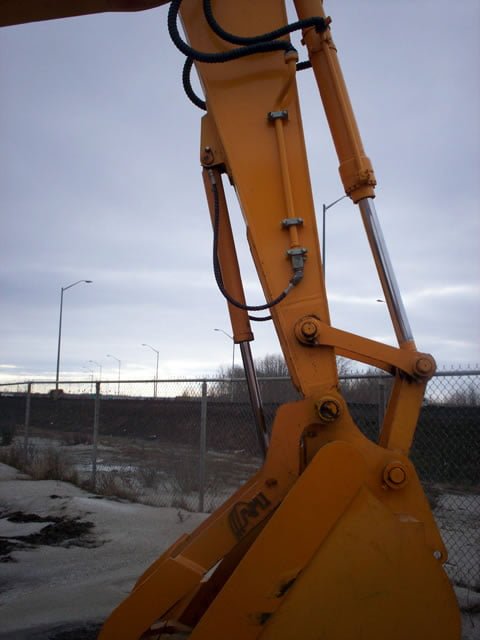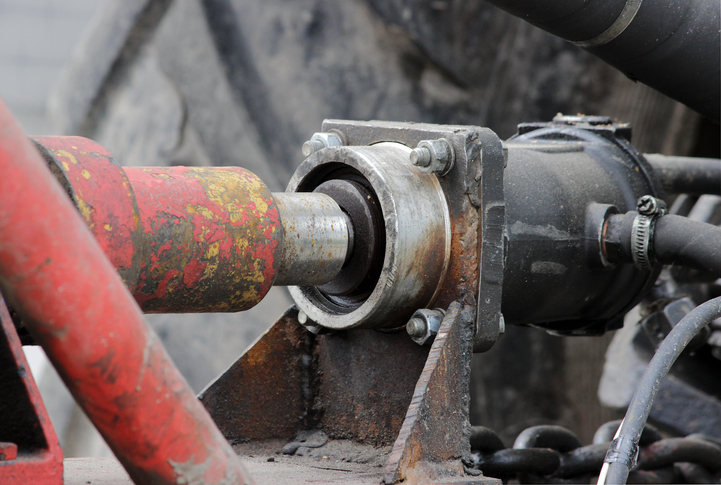Hydraulics is an efficient way to create mechanical energy and is at work in every industrial workplace in America. Put simply, hydraulic action employs pressurized fluid to move things.
Hydraulic systems can be found in lifts, heavy equipment, shock absorbers, braking systems, power steering, even spaceships. This type of system literally does a lot of heavy lifting, so when hydraulic fluid leaks occur, it’s important to:
How a Hydraulic System Works
The reason hydraulics are efficient is you can’t squash a liquid. When force is applied to liquid, it distributes that force outwardly and in a predictable way. When the action upon the liquid occurs in a larger area than the area upon which the liquid is acting upon, there is a force multiplier at work. Think of a hydraulic car jack: a person pushing on a lever moves fluid from the jack body into the small compartment that lifts the vehicle. This multiplies the human force applied by four or five times, allowing a person to lift a 2,000-pound vehicle off the ground.
Every hydraulic system is composed of four basic and essential elements:
- Hydraulic pump to push fluid into place
- Reservoir containing the hydraulic fluid
- Hoses and valves to facilitate and regulate the flow of fluid
- Hydraulic rams or motors to create hydraulic pressure
A signal is sent to the pump to draw fluid from the reservoir and direct it through an opened valve via the hoses to the motor. In some applications, the fluid is under immense pressure—5,000 pounds per square inch or more. That is about the maximum a slab of set concrete can support before breaking.
The motor or ram takes the hydraulic energy and converts it to mechanical energy—the stuff that moves things. A good example of this is a hydraulic excavator, which makes digging easier. Hydraulic fluid is pushed through long, narrow pipes into the short, wide rams, giving them the strength to lift hundreds of pounds of dirt and debris.
Diagnosing a Hydraulic Leak
Because hydraulic systems are all about fluids, the most common and pressing issue with them is a hydraulic leak. A hydraulic fluid leak reduces the amount of fluid that can multiply force and reduces the efficiency of the system. A significant loss of fluid can also wear out the hydraulic pump. It is important to fix hydraulic leaks as soon as they are diagnosed.
Most hydraulic fluid leaks are small and take time to affect the functioning of the equipment. This is both good and bad. On the one hand, they rarely spew liquid or cause the equipment to cease functioning on the spot. On the other hand, they require sleuthing to detect and locate.
What causes hydraulic leaks? They are generally the result of a breakdown in the segment of the system carrying the fluid from the place where pressure is applied to the place where it is distributed: in other words, the tubes that carry it and their connection points. The constant vibration on the system can cause connections between pipes and other elements to disengage. Wear and tear can cause cracks in the pipes as well. Seals in the hydraulic cylinders can get worn down over time and allow fluid to seep out. Whatever the source, hydraulic leak detection and repair are critical upkeep on any equipment using a hydraulic system.
Symptoms of Fluid Leak
These are the most common signs of a hydraulic fluid leak:
Puddling beneath the machine. This is a simple way to diagnose a leak. The base component of most hydraulic fluids is water, mineral oil, vegetable oil, or glycol, so the leaking fluid may be any color and is unlikely to have much odor.
Falling fluid levels. Hydraulic systems have fluid gauges for just this reason. Observe the level over several uses to determine if the level is dropping.
Poor performance. If the machine is running hot, or pressure is lacking, or it is suddenly making noises, these may be signs of a leak. Because leaks are the most common and reparable issue in hydraulic systems, they should always be considered and addressed first.
Many hydraulic machines, particularly those used in industry, work in dirty surroundings and may ordinarily be covered in oil and dirt. Determining and locating a leak can be difficult. With an industrial leak detection kit, the use of fluorescent dye helps detect the source of the leak.
How to Prevent Hydraulic Leaks
Regular maintenance of hydraulic systems is easy and critical to their proper functioning. Because hydraulics is a closed system, it tends to continue working properly without much maintenance. About the only regular attention it needs is lubricating the seals to slow their aging. It is important to follow the directions, using the right amount of the right lubricant. Using lubricant not designed for the seals in question can cause them to fail.
Making sure the fittings are tightened according to manufacturer’s specifications is an under-rated maintenance strategy. Over-tightened fittings can crack, and under-tightened fittings can cause leaks or allow contaminants to enter the hydraulic system. Air, water, chemicals or debris entering the system and mixing with the hydraulic fluid can cause significant damage and promote leakage anywhere in the system.
If there are filters in the hydraulic system, they must be replaced at regular intervals. This ensures that the hydraulic oil remains clean and uncontaminated. Check the manufacturer’s specifications to determine how often the filter should be changed.
How to Stop Hydraulic Fluid Leaks
After identifying a leak, the next step is to pinpoint it. To do that on small hydraulic systems, depressurize the system and check all the joints, seals and connectors while wearing gloves. Leaks at fittings and couplings may be fixed simply by tightening them. Damaged seals and hoses may need to be replaced.
For larger systems, a thorough understanding of fluid dynamics and hydraulic mechanics is necessary, along with equipment to test pressure, flow and temperature. Professional help may be required for larger hydraulic machines like diggers, brake systems and power steering.
If replacement isn’t an option you have for whatever reason, there are other solutions. For non-catastrophic leaks—things other than a broken hose that gushes liquid—a good first step is trying a hydraulic leak sealant like BlueDevil Hydraulic Stop Leak, which permanently seals hydraulic leaks or your money back. It comes in quart and gallon sizes; each gallon treats 20 gallons of hydraulic oil.
To repair a hydraulic leak using Hydraulic Stop Leak, turn off the equipment and pour one ounce per quart of hydraulic oil into the reservoir. Then run the equipment for an hour or two until the leaks cease. BlueDevil Hydraulic Stop Leak works by revitalizing hard, shrunken or cracked seals and hoses to their original condition and contains no petroleum distillates that can harm the system.
The Danger of Hydraulic Leaks
With just a little bit of maintenance, most hydraulic systems run dependably and efficiently forever. Allowing a leak to fester unaddressed is inviting trouble—the catastrophic failure of the equipment while it is running kind of trouble. In the case of a spaceship or aircraft, that could mean loss of life. In the case of a hydraulic excavator or power steering, it could be an expensive problem, both because the equipment is out of commission and because of the cost of repair. The downstream costs to a business of a piece of machinery on the blink can escalate as orders go unfilled, deadlines are missed, other equipment and staff are idled and so on.
How much will the hydraulic leak repair cost? That depends entirely on the equipment and the part or parts that require repair or replacement. An online estimate for a new Bosch hydraulic motor was $537-$896. Twelve inches of medium-strength, 5/8th inch hose is $35-$95. If the problem is a leak in a seal and replacement isn’t an option, try BlueDevil Hydraulic Stop Leak, which costs about $20 and takes three minutes to use, not counting the time required for the equipment to run and circulate it.
A leaking system can also be an environmental hazard as hydraulic fluid dribbles onto the ground or is released into the air. If fluid is constantly being refilled and leaking, it is like dumping it right into the environment. Water or mineral oil does not do much harm, but synthetic additives are rarely environmentally healthy.
Simple preventative maintenance and hydraulic fluid leaks repair can save lives, money and time. An ounce of prevention is worth a pound of cure, even for hydraulic systems.
BlueDevil Products can be found at AutoZone, Advance Auto Parts, O’Reilly Auto Parts, NAPA, Parts Authority, Auto Value, Bumper to Bumper and other major auto parts retailers.
BlueDevil Products can be found on Amazon.com or at AutoZone, Advance Auto Parts, O’Reilly Auto Parts, NAPA, and other major auto parts retailers.
5 responses to "Hydraulic Fluid Leaks: How to Diagnose and Fix Them"
5 Comments
Leave a Reply
Related Articles
Search Blog
Subscribe
Blog Categories




My loader is losing fluid and I can’t see the leak anywhere
Lana-
How quickly are you losing fluid? If you are not losing fluid too quickly, it may be worth trying the BlueDevil Hydraulic Stop Leak to help stop your fluid loss. The product is intended to treat rubber seals. You would use one oz. of the product per quart of fluid, and should expect to start seeing improvement after 1-2 hours of operation.
Thank you!
-BDP
The leak rate on my auto lift hydraulic cylinder when in lift mode is about a tablespoon per minute. How probable is it that a STOP LEAK FLUID such as BlueDevil hydraulic stop leak will stop this leak?
Bert-
Based on your description, you would be a good candidate for the BlueDevil Hydraulic Stop Leak. The product is intended for leaks that are seeping or lightly dripping. You should expect to start seeing results after 1-2 hours of operation.
Thank you!
-BDP
I have a wood splitter. The leak is at one of the joints where a half inch pipe connects the valve assembly to the hydrolic piston. It is a very steady stream while the piston is moving. I’m thinking I need to take the pipe off and either replace or at least put some plumbing tape on the threads. Thoughts?